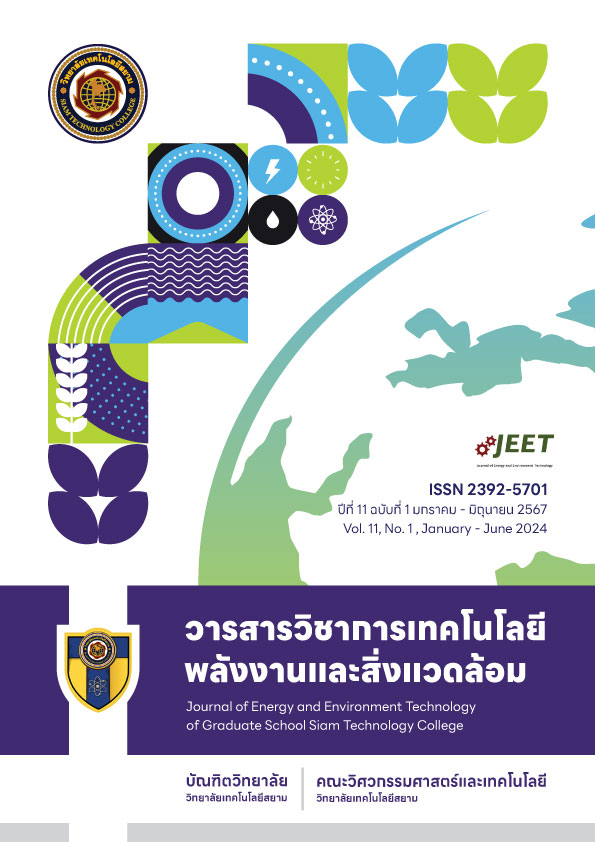EVALUATING THE CARBON FOOTPRINT OF ENERGY USE IN ROAD FREIGHT TRUCKING SYSTEMS: A CASE STUDY OF M.E. TRANS COMPANY LIMITED
Main Article Content
Abstract
Climate change is a significant factor impacting the environment and the sustainability of countries worldwide. Climate change is one of the most crucial issues of our time, and the transportation industry plays a vital role in generating carbon dioxide (CO2), which is a part of greenhouse gases (GHGs) that directly affect climate change. There is an awareness of the need to assess the carbon footprint of energy use in land freight transportation using trucks. Therefore, this research focuses on calculating GHG emissions using the greenhouse gas emission coefficient in units of carbon dioxide equivalent (CO2eq), following the guidelines of the Greenhouse Gas Management Organization (TGO). The objective is to study the energy data of land freight transportation activities by land freight operators using trucks and to evaluate the carbon footprint of energy use in the freight transportation system. Annual data collection from freight operators transporting goods to the southern provinces of Thailand was conducted. The research studied energy data from land freight operators' land freight transportation activities, including the quantity and destination provinces of the transportation routes per year. The transportation of goods originates from Samut Prakan province has transported to Songkhla province, with an average distance of 991.9 kilometers by large six-wheel trucks with a maximum load of 11 tons. The vehicles have consumed some diesel fuel, From the data recorded on the full truckload and empty running This makes the annual carbon dioxide emissions equal to 3,255.42 kgCO2eq/year and in the case of using large 10-wheel trucks the average maximum load weight is 16 tons. Using diesel as fuel emits carbon dioxide. It was found that when loading goods on the return trip, it was a 100% empty trip. There would be an amount of carbon dioxide released from the transportation of goods, with the use of vehicle fuel for transport by the operator equal to 7,275.59 kgCO2eq / year. For these reasons, in order to reduce greenhouse gas emissions, truck management methods using alternative fuels, biodiesel or other clean energy sources have lower emissions compared with diesel or gasoline, improving engine technology of renewable energy sources can significantly reduce the carbon footprint of cargo transportation, and adopting electric vehicles (EV) to provide services.
Article Details

This work is licensed under a Creative Commons Attribution-NonCommercial-NoDerivatives 4.0 International License.
เนื้อหาและข่อมูลในบทความที่ลงตีพิมพ์ในวารสารวิชาการ เทคโนโลยี พลังงาน และสิ่งแวดล้อม บัณฑิตวิทยาลัย วิทยาลัยเทคโนโลยีสยาม ถือเป็นข้อคิดเห็นและความรับผิดชอบของผู้เขียนบทความโดยตรง ซึ่งกองบรรณาธิการวารสารไม่จำเป็นต้องเห็นด้วย หรือว่าร่วมรับผิดชอบใด ๆ
บทความ ข้อมูล เนื้อหา รูปภาพ ฯลฯ ที่ได้รับการตีพิมพ์ในวารสารวิชาการ เทคโนโลยี พลังงาน และสิ่งแวดล้อม บัณฑิตวิทยาลัย วิทยาลัยเทคโนโลยีสยาม ถือเป็นลิขสิทธิ์ของวารสารวิชาการ เทคโนโลยี พลังงาน และสิ่งแวดล้อม บัณฑิตวิทยาลัย วิทยาลัยเทคโนโลยีสยาม หากบุคคล หรือหน่วยงานใดต้องการนำทั้งหมด หรือส่วนหนึ่งส่วนใดไปเผยแพร่ต่อ หรือเพื่อกระทำการใด ๆ จะต้องได้รับอนุญาต เป็นลายลักษณ์อักษรจากวารสารวิชาการ เทคโนโลยี พลังงาน และสิ่งแวดล้อม บัณฑิตวิทยาลัย วิทยาลัยเทคโนโลยีสยาม เท่านั้น
References
ศูนย์เทคโนโลยีสารสนเทศและการสื่อสาร. (2566). การปล่อยก๊าซคาร์บอนไดออกไซด์ (CO2) จากการใช้พลังงาน ปี 2566. รายงานสำนักงานนโยบายและแผนพลังงาน กระทรวงพลังงาน.
Krungthai Compass. Green Logistics เมื่อบริบทโลกเปลี่ยนไป การขนส่งสินค้าทางถนนไทยต้องเปลี่ยนตาม. รายงานธนาคารกรุงไทย. 2566.
ศูนย์ข้อมูลก๊าซเรือนกระจก รายงานผลการประเมินการปล่อยก๊าซเรือนกระจกภาคการขนส่ง (Transportation Sector) องค์การบริหารจัดการก๊าซเรือนกระจก (องค์การมหาชน). (2023, Dec. 8). [ออนไลน์]. แหล่งที่มา: http://conference.tgo.or.th/download/tgo_or_th/Article/2016/Article_GHG_Emissions_TransportSector_Final.pdf
Glen Winkfield. GHG INSIGHT. (2023, Apr.3). [ออนไลน์]. แหล่งที่มา: https://www.ghginsight.com/
uncategorized/what-are-scopes/
Jin Li Qihui Lu and Peihua Fu, “Carbon Footprint Management of Road Freight Transport under the Carbon Emission Trading Mechanism”, Hindawi Publishing Corporation Mathematical Problems in Engineering,2015, Article ID 814527
Thai National LCI Database. Emission Factor Classified by Industry Group Type 2020. (2023, Dec.8). [online]: http://thaicarbonlabel.tgo.or.th/admin/uploadfiles/emission/ts_117a1351b6.pdf
สุพรรณี มีสุข และ สุพรรณนิกา วัฒนะ. การประเมินคาร์บอนฟุตพริ้นท์ของผลิตภัณฑ์เบียร์. ใน การประชุมวิชาการเสนอผลงานวิจัยระดับบัณฑิตศึกษาระดับชาติ ครั้งที่ 23. (น. 213-225). มหาวิทยาลัยขอนแก่น.
ศรายุทธ เรืองผล. (2559). การประเมินการปล่อยก๊าซเรือนกระจกจากภาคขนส่งทางบกกลุ่มจังหวัดอันดามัน ประเทศไทย. วิทยานิพนธ์ ปริญญาวิทยาศาสตรมหาบัณฑิต มหาวิทยาลัยสงขลานครินทร์.
ณัฐสิมา โทขันธ์ ณหทัย โชติกลาง กนกวรรณ ปุณณะตระกูล และอัจฉราพร สมภาร. (2566) การประเมินคาร์บอนฟุตพริ้นท์สำหรับเมนูผัดไทยวไลยอลงกรณ์” วารสารวิทยาศาสตร์และเทคโนโลยี มหาวิทยาลัยราชภัฏอุดรธานี, 11(1), 93-107.
สุรวุฒิ สุดหา และ ดุษฎีพร หิรัญ (2566). ผลกระทบเชิงเศรษฐศาสตร์สิ่งแวดล้อมในการกำหนดนโยบายระบบขนส่งสาธารณะภายในสถาบันการศึกษาและชุมชนเพื่อเข้าสู่การเป็นมหาวิทยาลัยสีเขียว กรณีศึกษา มหาวิทยาลัยราชภัฏชัยภูมิ. วารสารการบริหารการปกครองและนวัตกรรมท้องถิ่น, 7(3), 171-190


